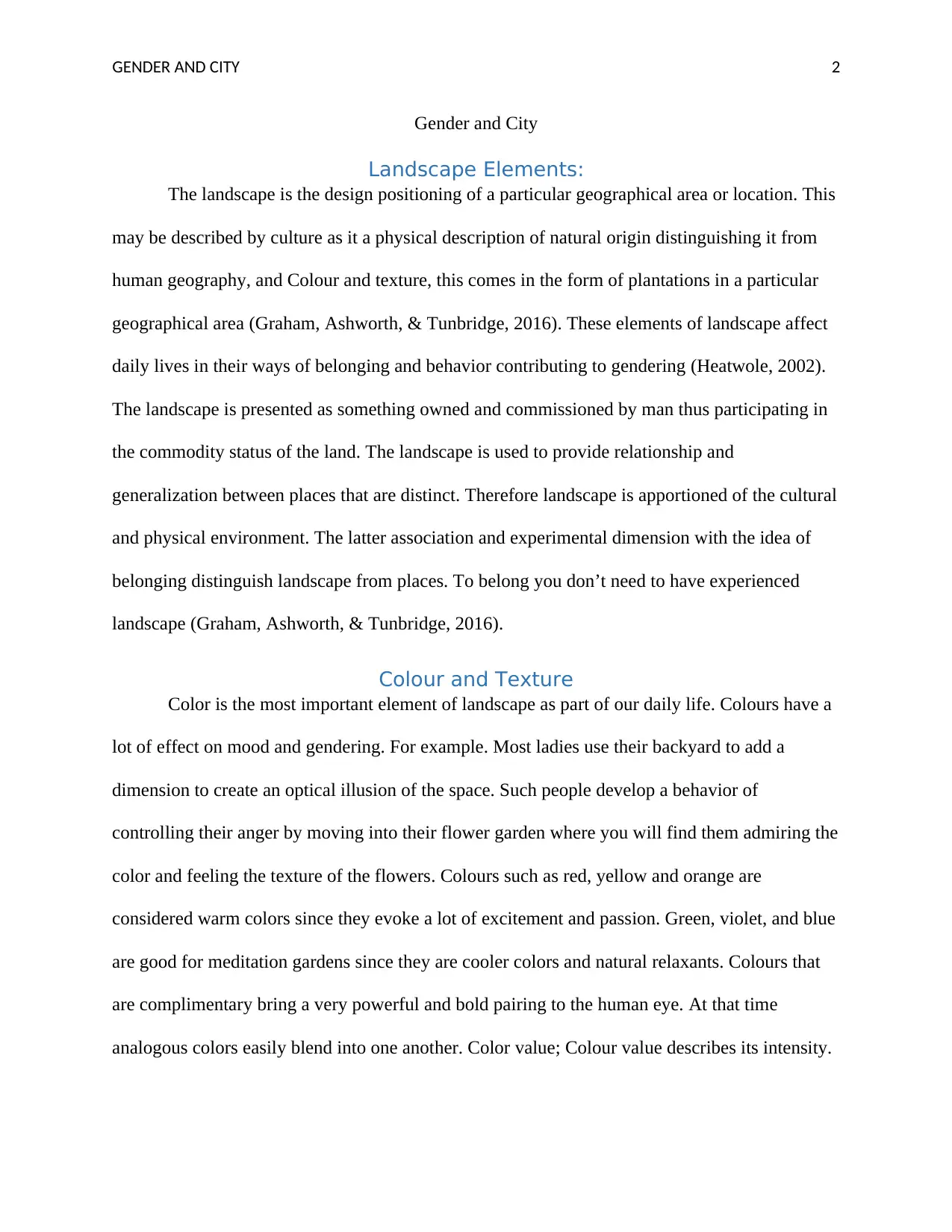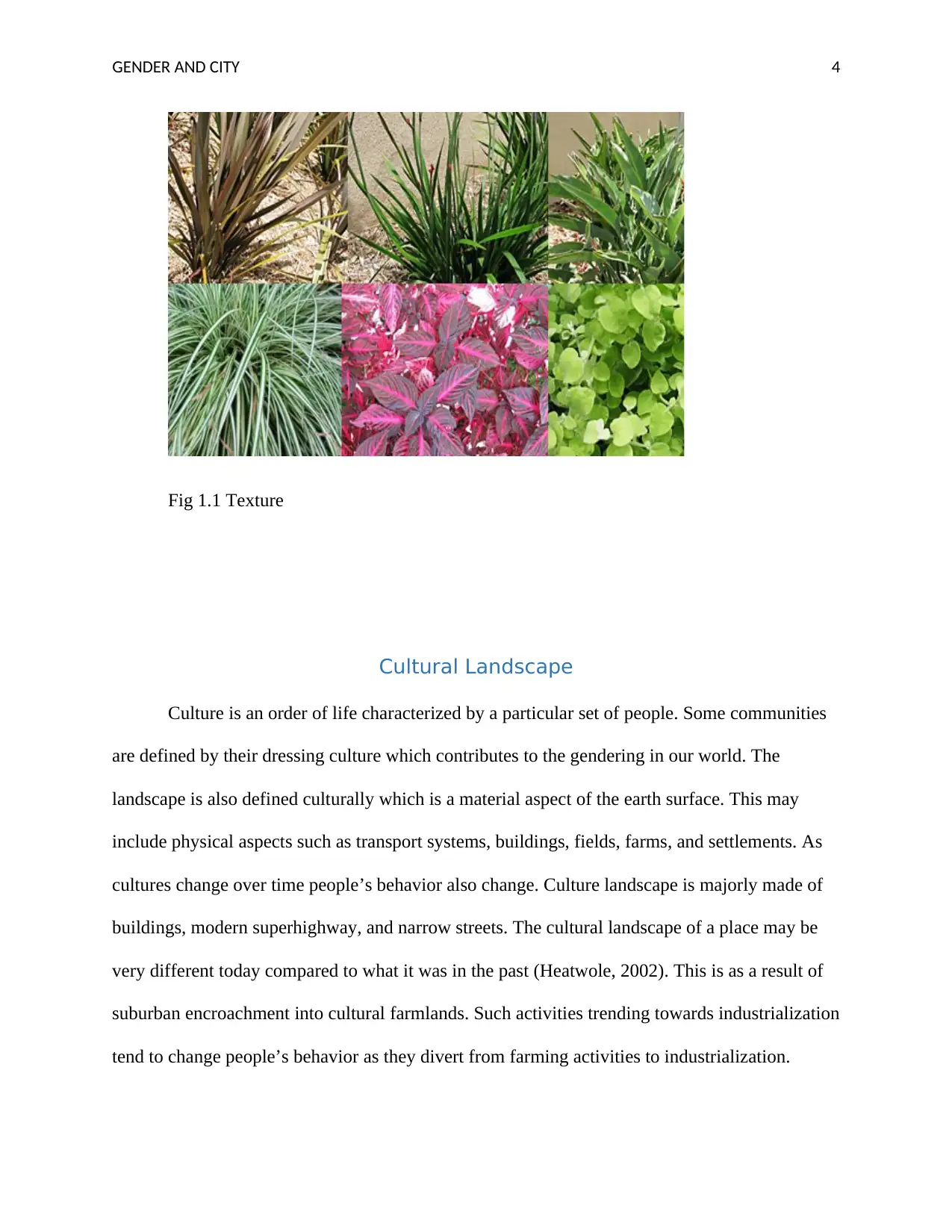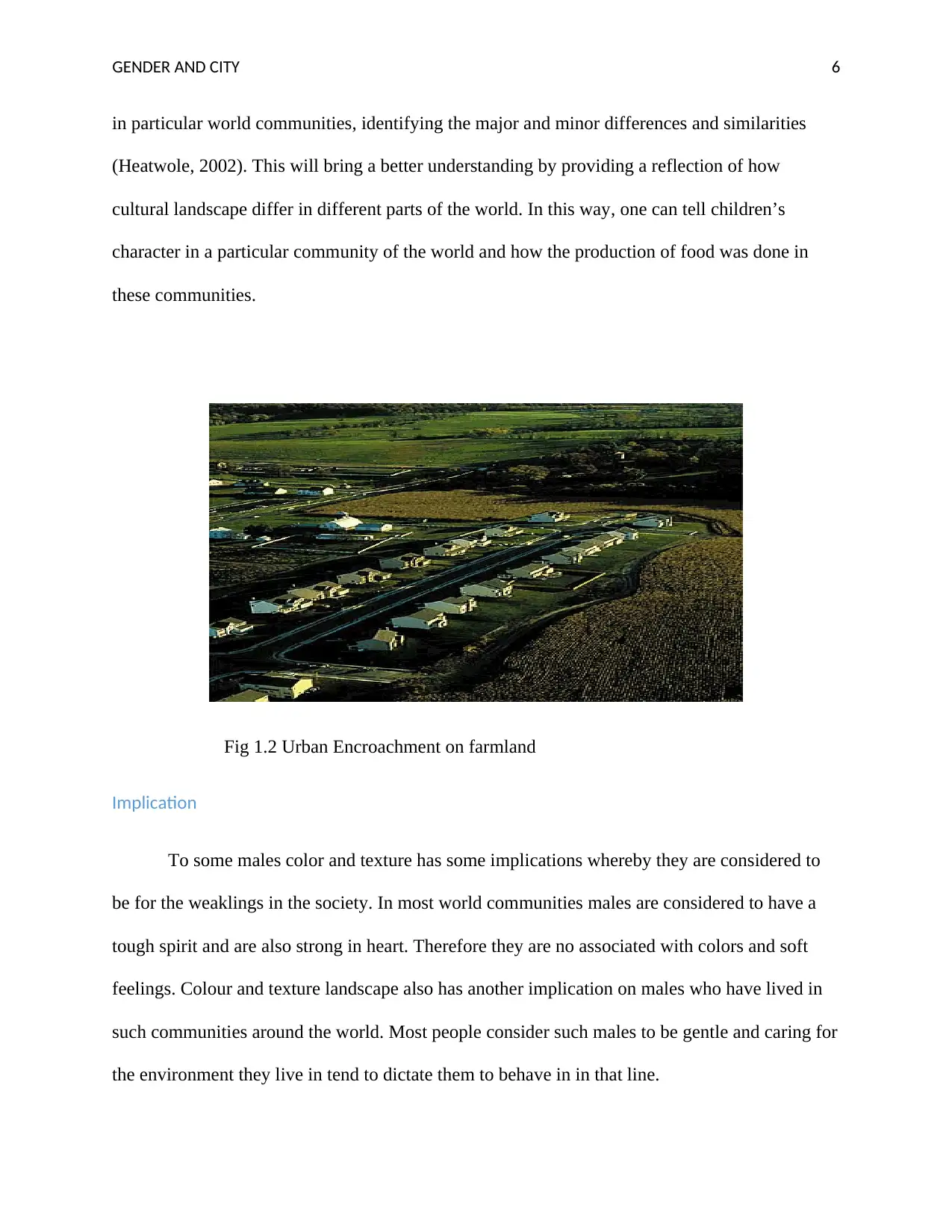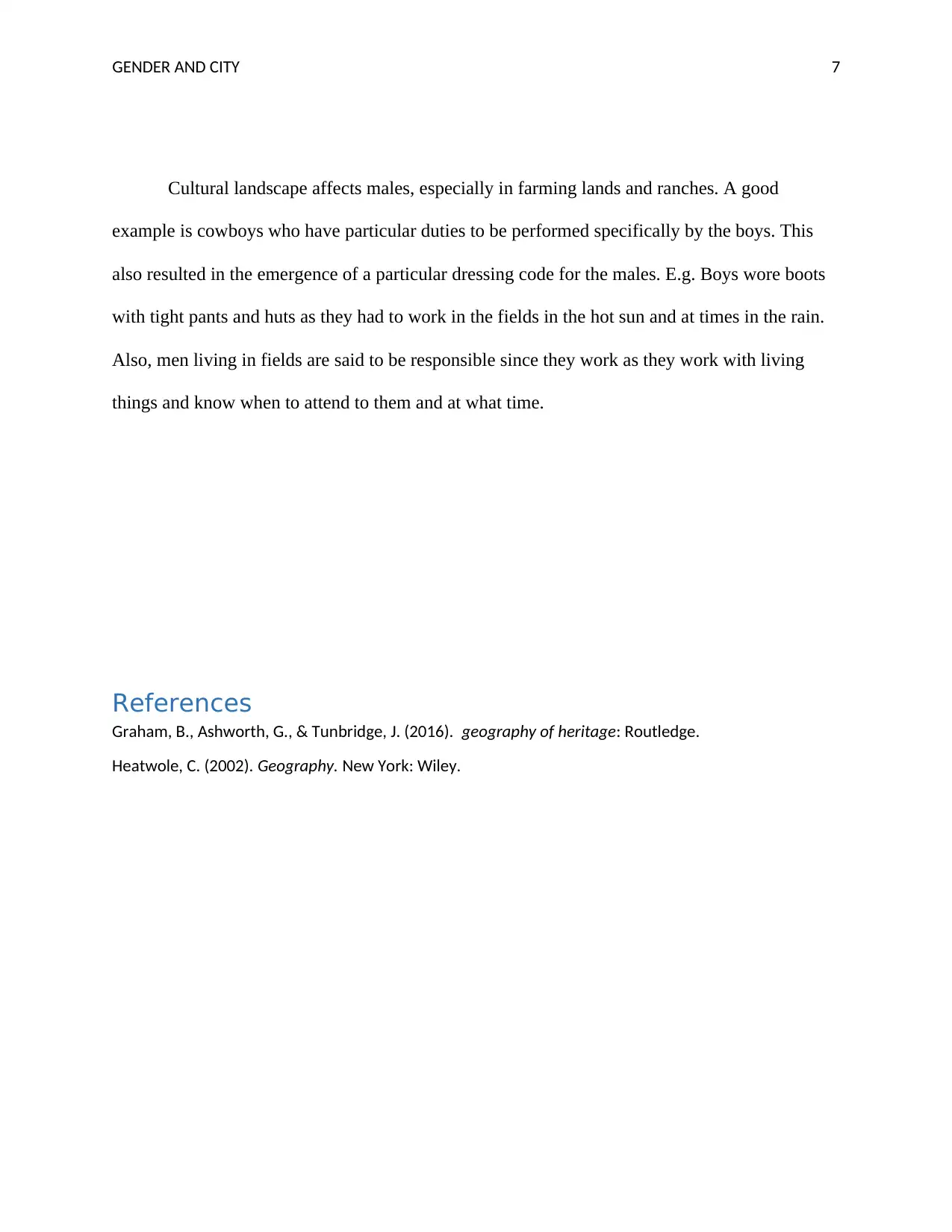Essay on Gender, City Landscape Elements, and Cultural Impact
VerifiedAdded on 2020/03/23
|7
|1192
|152
Essay
AI Summary
This essay examines the intricate relationship between gender and the urban landscape, focusing on how landscape elements such as color and texture, as well as cultural factors, shape behaviors and influence a sense of belonging. The essay explores how these elements contribute to gendering, highlighting the significance of landscape design and its impact on daily life. It also delves into the cultural landscape, including how it is defined and how it changes over time due to factors like suburban encroachment. The analysis includes the implications of these factors on different genders, particularly in the context of traditional gender roles and behaviors. The essay references scholarly sources to support its arguments, providing a comprehensive overview of the topic.

Running head: GENDER AND CITY 1
Gender and City
Name
Student Number
Instructor’s Name
Date
Gender and City
Name
Student Number
Instructor’s Name
Date
Paraphrase This Document
Need a fresh take? Get an instant paraphrase of this document with our AI Paraphraser

GENDER AND CITY 2
Gender and City
Landscape Elements:
The landscape is the design positioning of a particular geographical area or location. This
may be described by culture as it a physical description of natural origin distinguishing it from
human geography, and Colour and texture, this comes in the form of plantations in a particular
geographical area (Graham, Ashworth, & Tunbridge, 2016). These elements of landscape affect
daily lives in their ways of belonging and behavior contributing to gendering (Heatwole, 2002).
The landscape is presented as something owned and commissioned by man thus participating in
the commodity status of the land. The landscape is used to provide relationship and
generalization between places that are distinct. Therefore landscape is apportioned of the cultural
and physical environment. The latter association and experimental dimension with the idea of
belonging distinguish landscape from places. To belong you don’t need to have experienced
landscape (Graham, Ashworth, & Tunbridge, 2016).
Colour and Texture
Color is the most important element of landscape as part of our daily life. Colours have a
lot of effect on mood and gendering. For example. Most ladies use their backyard to add a
dimension to create an optical illusion of the space. Such people develop a behavior of
controlling their anger by moving into their flower garden where you will find them admiring the
color and feeling the texture of the flowers. Colours such as red, yellow and orange are
considered warm colors since they evoke a lot of excitement and passion. Green, violet, and blue
are good for meditation gardens since they are cooler colors and natural relaxants. Colours that
are complimentary bring a very powerful and bold pairing to the human eye. At that time
analogous colors easily blend into one another. Color value; Colour value describes its intensity.
Gender and City
Landscape Elements:
The landscape is the design positioning of a particular geographical area or location. This
may be described by culture as it a physical description of natural origin distinguishing it from
human geography, and Colour and texture, this comes in the form of plantations in a particular
geographical area (Graham, Ashworth, & Tunbridge, 2016). These elements of landscape affect
daily lives in their ways of belonging and behavior contributing to gendering (Heatwole, 2002).
The landscape is presented as something owned and commissioned by man thus participating in
the commodity status of the land. The landscape is used to provide relationship and
generalization between places that are distinct. Therefore landscape is apportioned of the cultural
and physical environment. The latter association and experimental dimension with the idea of
belonging distinguish landscape from places. To belong you don’t need to have experienced
landscape (Graham, Ashworth, & Tunbridge, 2016).
Colour and Texture
Color is the most important element of landscape as part of our daily life. Colours have a
lot of effect on mood and gendering. For example. Most ladies use their backyard to add a
dimension to create an optical illusion of the space. Such people develop a behavior of
controlling their anger by moving into their flower garden where you will find them admiring the
color and feeling the texture of the flowers. Colours such as red, yellow and orange are
considered warm colors since they evoke a lot of excitement and passion. Green, violet, and blue
are good for meditation gardens since they are cooler colors and natural relaxants. Colours that
are complimentary bring a very powerful and bold pairing to the human eye. At that time
analogous colors easily blend into one another. Color value; Colour value describes its intensity.

GENDER AND CITY 3
A photograph taken in black and white appear in grey shades. This is brought about by the
varying difference in light and dark.
Value is an important factor to consider when choosing bold colors. Others also tend to
enjoy feeling the texture, as the texture is the feel and look of plants surface. The texture is a
great way to bring variety into your garden. Unlike color different texture create harmony in your
landscape. You can balance out coarse-textured plants with smoothly textured ones or mix plants
with larger leaves and smaller leaves. This breaks up your landscape, adding interest and mood
to your backyard (Heatwole, 2002).
Fig 1.0 color
A photograph taken in black and white appear in grey shades. This is brought about by the
varying difference in light and dark.
Value is an important factor to consider when choosing bold colors. Others also tend to
enjoy feeling the texture, as the texture is the feel and look of plants surface. The texture is a
great way to bring variety into your garden. Unlike color different texture create harmony in your
landscape. You can balance out coarse-textured plants with smoothly textured ones or mix plants
with larger leaves and smaller leaves. This breaks up your landscape, adding interest and mood
to your backyard (Heatwole, 2002).
Fig 1.0 color
⊘ This is a preview!⊘
Do you want full access?
Subscribe today to unlock all pages.

Trusted by 1+ million students worldwide

GENDER AND CITY 4
Fig 1.1 Texture
Cultural Landscape
Culture is an order of life characterized by a particular set of people. Some communities
are defined by their dressing culture which contributes to the gendering in our world. The
landscape is also defined culturally which is a material aspect of the earth surface. This may
include physical aspects such as transport systems, buildings, fields, farms, and settlements. As
cultures change over time people’s behavior also change. Culture landscape is majorly made of
buildings, modern superhighway, and narrow streets. The cultural landscape of a place may be
very different today compared to what it was in the past (Heatwole, 2002). This is as a result of
suburban encroachment into cultural farmlands. Such activities trending towards industrialization
tend to change people’s behavior as they divert from farming activities to industrialization.
Fig 1.1 Texture
Cultural Landscape
Culture is an order of life characterized by a particular set of people. Some communities
are defined by their dressing culture which contributes to the gendering in our world. The
landscape is also defined culturally which is a material aspect of the earth surface. This may
include physical aspects such as transport systems, buildings, fields, farms, and settlements. As
cultures change over time people’s behavior also change. Culture landscape is majorly made of
buildings, modern superhighway, and narrow streets. The cultural landscape of a place may be
very different today compared to what it was in the past (Heatwole, 2002). This is as a result of
suburban encroachment into cultural farmlands. Such activities trending towards industrialization
tend to change people’s behavior as they divert from farming activities to industrialization.
Paraphrase This Document
Need a fresh take? Get an instant paraphrase of this document with our AI Paraphraser

GENDER AND CITY 5
Cultural components are not only limited to humans but it is characterized with the earth
as well. Humans primarily use their culture where possible to modify and interact and blend in
with the earth surface (Graham, Ashworth, & Tunbridge, 2016). These activities include
Acquainting ecological concept to a particular culture
Listing and providing ways for people to adapt and blend in with the physical
environment e.g. clothing, agriculture, and housing styles.
Identifying the factors which attracted settlers to inhabited and settle in new areas
that were considered selected world communities.
Providing agricultural practices of the environmental factors that were practiced
in particular areas of the world.
A description of the characteristics of climate in various communities and their
effect on the lives of the people who reside there.
The use of natural resources by the early settlers in the world community.
Identify ways in which these items reflect human interaction with the natural
environment.
There is culture region which is a portion of the earth with common elements of culture
that identify the mapped cultural regions. This provides the location of a particular cultural
community with particular traits of culture. (Heatwole, 2002). The Cultural landscape has some
activities to acquaint third graders; Comparing land and houses used in rural, suburban and urban
Cultural components are not only limited to humans but it is characterized with the earth
as well. Humans primarily use their culture where possible to modify and interact and blend in
with the earth surface (Graham, Ashworth, & Tunbridge, 2016). These activities include
Acquainting ecological concept to a particular culture
Listing and providing ways for people to adapt and blend in with the physical
environment e.g. clothing, agriculture, and housing styles.
Identifying the factors which attracted settlers to inhabited and settle in new areas
that were considered selected world communities.
Providing agricultural practices of the environmental factors that were practiced
in particular areas of the world.
A description of the characteristics of climate in various communities and their
effect on the lives of the people who reside there.
The use of natural resources by the early settlers in the world community.
Identify ways in which these items reflect human interaction with the natural
environment.
There is culture region which is a portion of the earth with common elements of culture
that identify the mapped cultural regions. This provides the location of a particular cultural
community with particular traits of culture. (Heatwole, 2002). The Cultural landscape has some
activities to acquaint third graders; Comparing land and houses used in rural, suburban and urban

GENDER AND CITY 6
in particular world communities, identifying the major and minor differences and similarities
(Heatwole, 2002). This will bring a better understanding by providing a reflection of how
cultural landscape differ in different parts of the world. In this way, one can tell children’s
character in a particular community of the world and how the production of food was done in
these communities.
Fig 1.2 Urban Encroachment on farmland
Implication
To some males color and texture has some implications whereby they are considered to
be for the weaklings in the society. In most world communities males are considered to have a
tough spirit and are also strong in heart. Therefore they are no associated with colors and soft
feelings. Colour and texture landscape also has another implication on males who have lived in
such communities around the world. Most people consider such males to be gentle and caring for
the environment they live in tend to dictate them to behave in in that line.
in particular world communities, identifying the major and minor differences and similarities
(Heatwole, 2002). This will bring a better understanding by providing a reflection of how
cultural landscape differ in different parts of the world. In this way, one can tell children’s
character in a particular community of the world and how the production of food was done in
these communities.
Fig 1.2 Urban Encroachment on farmland
Implication
To some males color and texture has some implications whereby they are considered to
be for the weaklings in the society. In most world communities males are considered to have a
tough spirit and are also strong in heart. Therefore they are no associated with colors and soft
feelings. Colour and texture landscape also has another implication on males who have lived in
such communities around the world. Most people consider such males to be gentle and caring for
the environment they live in tend to dictate them to behave in in that line.
⊘ This is a preview!⊘
Do you want full access?
Subscribe today to unlock all pages.

Trusted by 1+ million students worldwide

GENDER AND CITY 7
Cultural landscape affects males, especially in farming lands and ranches. A good
example is cowboys who have particular duties to be performed specifically by the boys. This
also resulted in the emergence of a particular dressing code for the males. E.g. Boys wore boots
with tight pants and huts as they had to work in the fields in the hot sun and at times in the rain.
Also, men living in fields are said to be responsible since they work as they work with living
things and know when to attend to them and at what time.
References
Graham, B., Ashworth, G., & Tunbridge, J. (2016). geography of heritage: Routledge.
Heatwole, C. (2002). Geography. New York: Wiley.
Cultural landscape affects males, especially in farming lands and ranches. A good
example is cowboys who have particular duties to be performed specifically by the boys. This
also resulted in the emergence of a particular dressing code for the males. E.g. Boys wore boots
with tight pants and huts as they had to work in the fields in the hot sun and at times in the rain.
Also, men living in fields are said to be responsible since they work as they work with living
things and know when to attend to them and at what time.
References
Graham, B., Ashworth, G., & Tunbridge, J. (2016). geography of heritage: Routledge.
Heatwole, C. (2002). Geography. New York: Wiley.
1 out of 7
Your All-in-One AI-Powered Toolkit for Academic Success.
+13062052269
info@desklib.com
Available 24*7 on WhatsApp / Email
![[object Object]](/_next/static/media/star-bottom.7253800d.svg)
Unlock your academic potential
Copyright © 2020–2025 A2Z Services. All Rights Reserved. Developed and managed by ZUCOL.